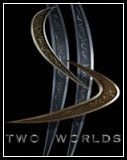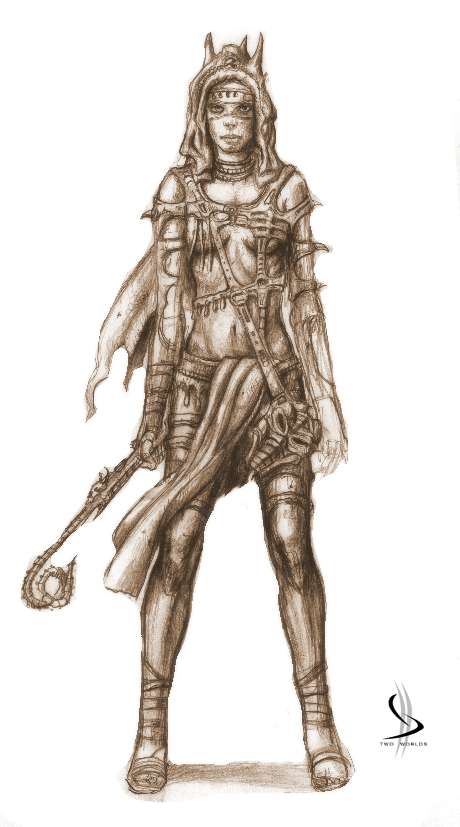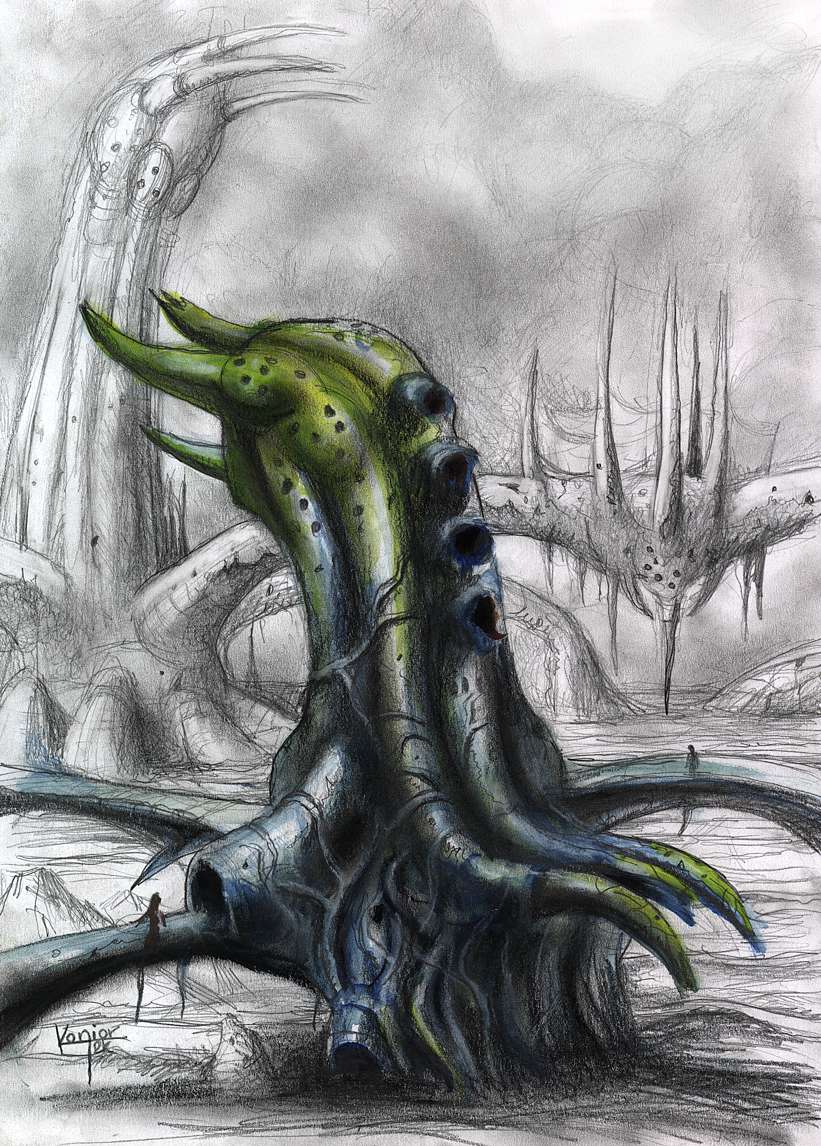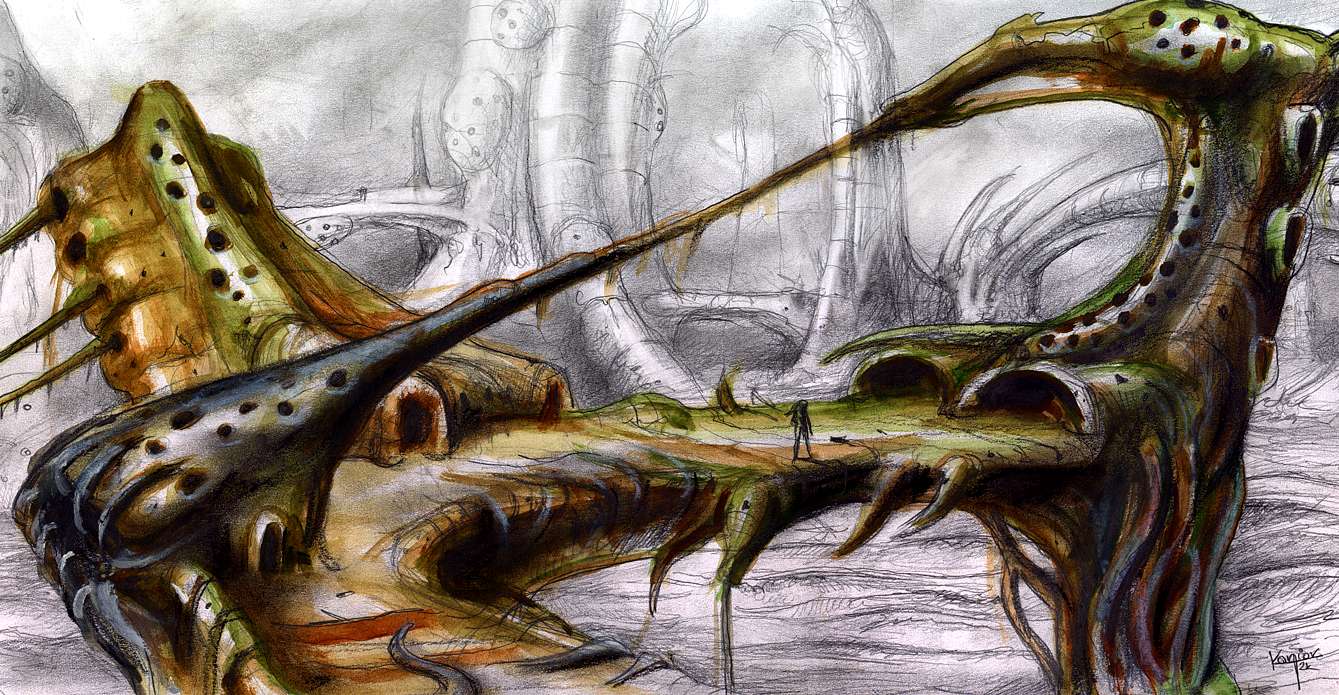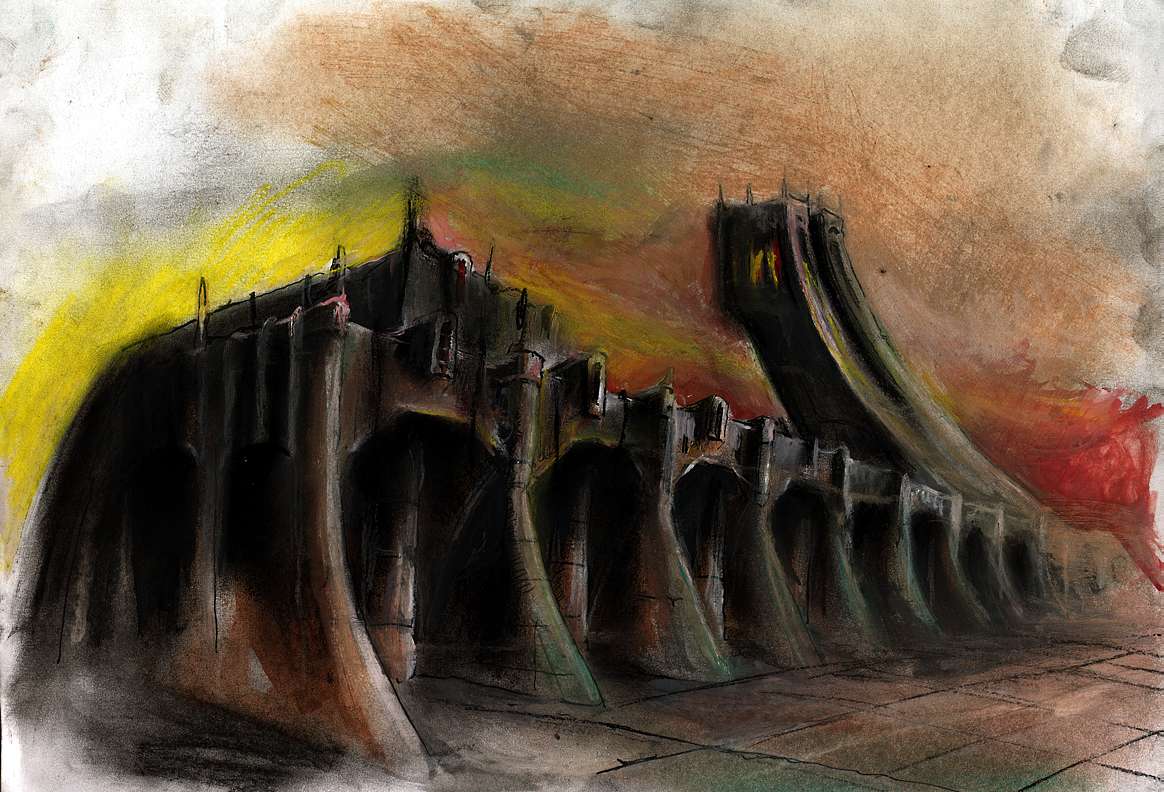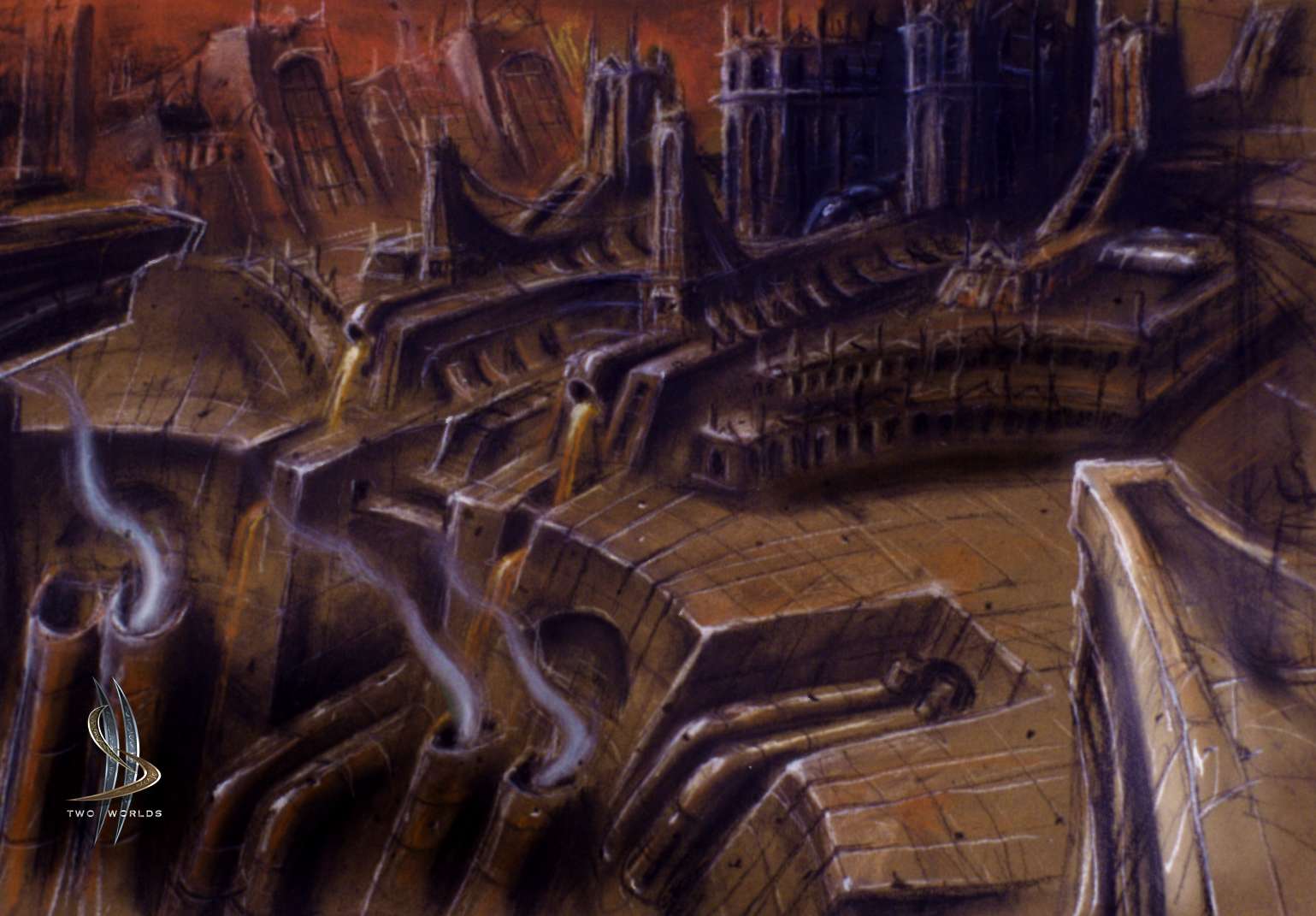Meta:Two Worlds Interview
This Q&A was posted to the website rpgvault.ign.com by Jonric - Richard Aihoshi on March 03, 2000.[1]
Questions and Answers
The Kroth Universe is a peaceful place populated by thousands of completely isolated races that do not even know of each other's existence due to space dust that prevents interplanetary travel and even communication. Then, in a fateful instant, a space/time collision causes two worlds to meet. Their respective inhabitants, two very different races known as the Quidarians and en'Ceer, are thrown into a bitter conflict from which only one can emerge victorious.
This is the recently revealed story outline for Two Worlds, the latest project for Polish developer Metropolis Software House. Like the studio's previous title, Odium/Gorky 17, it will combine role-playing and strategy elements. Other than this, very little else has been made known to date. As a result, it was a pleasure to learn more in the first-ever Two Worlds interview with CEO Grzegorz Miechowski, Game Designer/Project Manager Michal Doniec and Director of Development Bartosz Brzostek.
Jonric: Since our readers may only know Metropolis Software House in connection with Gorky 17/Odium, please introduce the company and the core design team on Two Worlds. How many people are on the team in total?
Grzegorz Miechowski: The core design team is Game Designer Michal Doniec who co-designed FireFight published by AE in 1996 and awarded by PC Gamer US and Adrenaline Vault as the best shooter of the year, and Bartek Brzostek, our Director of Development with great experience in programming. Also graphic artist Irek Konior, who draws concept artworks, has an influence on the design issues. In total, there are 15 people in the team.
Metropolis started game development in 1992. Our first release was small adventure game only for the Polish market. Up to today, we have released six titles.
Jonric: Let's start with an overview of the game. In about 100 words or less, how would you summarize Two Worlds?
Michal Doniec: Two Worlds is a creative mix of RPG and adventure games with a "tactical level" real-time combat system. Also, it's very story driven - there are several layers of conflict such as between the Quidarian and en'Ceer governments, and between Ned Jash, our main hero and one of prominent en'Ceer race members (I'll not reveal her name yet :)). The whole action of Two Worlds is set in a completely original universe, so I think we have something fresh to offer. There are a lot of very good fantasy RPG games on the market, so we have decided to go into another direction and give players the possibility to explore something new.
Jonric: What kind of background do you have as a gamer? What games have most influenced you as a game maker?
Michal Doniec: First computer game I was playing was Pong - it was more than 15 years ago. Then I've got a Spectrum 48k (it was a Timex in the States I think). I started to play every game I could get - like Mooncresta, Knight Lore, and Alien 8.
I was always very interested in pen and paper RPGs. I have played a lot of it, and I must say that pen and paper games, especially more adult-oriented like all the games set in World Of Darkness (White Wolf) have a big impact on the things I am doing now. Also some battle games like Warhammer Fantasy Battle have influenced me a lot.
Jonric: How and when did the idea for Two Worlds come about?
Michal Doniec: More than three years ago, I was thinking about game concept for a company I was working for. I thought it would be very interesting to see how a technology-driven world can compete with a magic world; you know - what would happen if I put a retired SAS commandos in front of powerful witch - who will survive. Meanwhile, I left that company, and dropped the project into a drawer. A year ago, when I started to work at Metropolis I got it back and started to work on world settings, mythology and similar things. The concept was polished and funny things like the witches and SAS commandos were removed, but the whole idea of conflict between technology and psychology was even more exposed. When we finished Gorky 17 and Metropolis was in need of new project, Two Worlds' concept and story was almost ready.
Jonric: Cool timing. Please describe the game world in Two Worlds. Why did you choose to go from a very realistic setting in Gorky 17 to a completely alien one in Two Worlds?
Michal Doniec: Hmm a simple answer is that we wanted to do something different and explore some new possibilities; a realistic setting has some constraints. Anyway, Two Worlds is not set in a completely alien world. Ras Hadarian - en'Ceers planet will look more alien-like, but Quidarian's world is rather similar to ours. It looks like a normal city, but with a bit more monumental architecture which emphasizes the Quidarians' social system. There are no green-skin, big eyes, one (or ten :) ) meter tall aliens. Quidarians look like humans, en'Ceers are humanoid species. I'd risk an answer that Gorky 17/Odium was sometimes more alien-like than Two Worlds is.
Jonric: What is the back story leading up to the start of the game? Will there be a strong storyline in the game itself? How linear or non-linear will the game be overall?
Michal Doniec: Please check our page (www.metropolis.com.pl) from time to time. I'll post "Quidarian Chronicles" and some Quidarian Intelligence materials every month - it will reveal a lot of "before the game" information.
As for Two Worlds itself, it is a story driven game so conflict and characters are very important. There is a lot of non-linearity; almost every task can be completed in more than one way, and there are story related sub-quests. There is something else I can't talk about right now because it's very important part of the story, but I can say it's "the most important non-linear element of game" :).
Jonric: OK - for now. Will players have any choice in the starting character or starting abilities? Will there be any character generation, or will the action begin right away? Why did you choose this way?
Michal Doniec: The player can't choose a character; the game will start with Ned Jash as pre-defined hero. But there will be a possibility of modification of statistics very early in the game, so the player will be able to choose which abilities are most important to him.
It's very hard to write a story for every possible character - you must know his motivations, something about his past, about his allies and enemies. Imagine Robin Williams playing Terminator - it isn't possible (IMHO :) ).
Of course there is a place for modifications - a change in character's intelligence or strength will have impact on the story, but main goal will remain unchanged, and the player will just choose a different way to achieve it.
Jonric: How will the character development system work during the course of the game? Will it be skill-based, level-based, some combination, or something else?
Michal Doniec: It is a combination of a level-based system with a weapon skill system. Weapon skills are similar to the Gorky17/Odium system. If you use one particular weapon many times, its level will rise, and you will be able to use it more efficiently. Characters will have some basic stats and special skills, and there will be much more emphasis on character development in Two Worlds than there was in Gorky17/Odium.
Jonric: Considering this increased emphasis on character, do you categorize Two Worlds within any particular genre label?
Michal Doniec: I'd call Two Worlds RPS (Role Playing Strategy) because combat system is almost as much important for us as RPG elements like character development, strong story, quests etc. But, I must emphasize that Two Worlds is not a real-time strategy with a bit of character development. There will be no massive tank rushes, resource digging etc.
Jonric: Will there be major quests or missions in Two Worlds? Will it be necessary to play them in a linear order?
Michal Doniec: The whole game is mission-based, but these missions are not like in regular strategy games. Every mission is a part of the story, there are no "go, destroy this building without reason" type things. You may think of these missions as chapters or something like that. You will have to play them in linear order, but there are many ways to achieve main goals. You will be able to go back from mission to mission to finish some sub-quests. There will be different paths, and it will depend on player decision which path through a game he will choose.
Jonric: Please describe the combat system. How important will combat be? Will it be possible to use non-violent means as well as combat to deal with situations?
Michal Doniec: Combat will be more on the tactical level. You will have to deal with few, but very intelligent enemies, plan your actions ahead, and sometimes you will have to avoid fighting at all. We have designed some mechanisms which will allow very precise planning of actions and control of your main character and his friends.
Because the whole game is about conflict, combat will play rather important role. But it will be possible to convince some enemies, and not to fight with them. And the opposite as well; you will be able to make a step in the wrong direction, and someone, neutral or even friendly before will become hostile.
Jonric: Please describe your new Wireframe Engine. What are its main features? Will it be full 3D this time, or a 2D/3D combination?
Bartosz Brzostek: The Wireframe Engine is a complete environment for creating RPG-like games. When designing it, our priority was to provide efficient tools for designers to create a complex, believable world and to achieve a state of the art technology level.
Our Wireframe Engine is full 3D. Currently it's OpenGL based, and a DirectX port will be provided later. We will try to support all new technologies, including hardware Transformation and Lighting. Although the engine is designed to be scalable among different hardware, no software rendering is planned. The engine is independent from the resolution or color depth. The more powerful hardware, the higher the screen resolution and the better the look of the game.
The Wireframe Engine provides support for multi-player games. We are working on something special for Internet players, something that points beyond the scope of Two Worlds project.
Jonric: How about an auto-journal of some sort? Will players be able to add their own map and journal notes?
Michal Doniec: Yes, there will be a journal which will keep track of the player's actions, and the player will be able to add his own notes to it. We have plans for an auto-mapper but it's too early to talk about it.
Jonric: What will make your game stand out from the other games that will be released around the same time? To what kind of game player will Two Worlds appeal?
Michal Doniec: We have a very rich and original game world, complete with mythology, believable characters and strong story. If someone is looking for something different than standard fantasy setting, Two Worlds will be for him. We have also plans for some surprises in our weapon/artifact system, but more on this later. Two Worlds will be a crossover game, and should appeal to both RPG and strategy fans who played Fallout, Baldur's Gate and Command and Conquer before.
Jonric: Cool. And to finish up, is there anything else you'd like to say to our readers?
Michal Doniec: Yes, we have set up a Two Worlds forum at www.metropolis.com.pl, so please feel free to come there, ask questions and give us suggestions. We are making games for gamers, so we would like to hear your opinions.
Jonric: Well, now that they've had the chance to learn a bit more about Two Worlds, we suspect many computer gaming fans will want to watch the development of the game, and will also be eager to submit questions and comments to the team. In the meantime, thanks very much to Grzegorz, Michal and Bartosz for allowing us to bring our readers the first look at their new game.
Jonric - Richard Aihoshi
